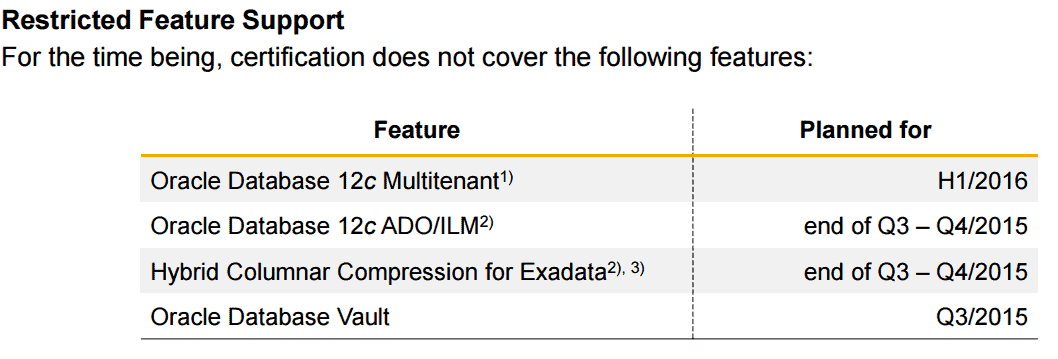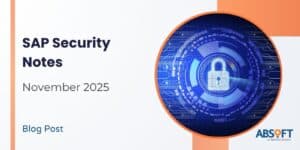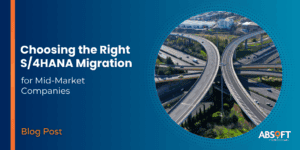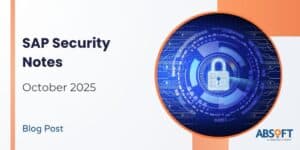Why Stay with Oracle?
After my blog on Seven Reasons to Upgrade to SQL Server 2014 was reasonably well received, I’ve collected some thoughts on benefits you can use to make a business case for upgrading to Oracle 12c for your SAP landscape.
If you are planning changes to your SAP landscape, now is the time to look at the SAP HANA database.  There shouldn’t be any reason that you can’t migrate to Suite on HANA or upgrade to S/4HANA when you next require an OS, DB or hardware change.
Some of the performance improvements you can get from SAP HANA are incredible. Even without any optimisation and new innovation from SAP is focused on HANA.  It is enterprise ready and in production use now.
However, if you can’t use HANA for organisational or budgetary reasons, you can stick with Oracle or SQL Server.¬† Both are supported by SAP until at least 2025. However, all the promotion of HANA has made it harder to see the benefits of the latest versions. In other words, this blog is a collection of reasons to consider an upgrade to Oracle 12c.
Reason 1. Avoid extended support costs and stay supported by SAP and Oracle
Extended support for Oracle 10 ended July 2015 for all platforms apart from Itanium, where it ends December 2015.  If you are still running Oracle 10 you need to upgrade immediately as you are at risk of hitting an issue and not getting support from SAP or Oracle, and you will get no critical patch updates.
Oracle 11g has been under extended support since 1st February 2015.  Extended support is free until 31st May 2017, but you will be charged for extended support for Oracle 11g from June 2017.  Extended support for release 11.2.0.3 ended on 27th August 2015 so you need to apply a bundle patch immediately if you are on 11.2.0.3 or lower.  11g extended support is only available on release 11.2.0.4.
Support for Oracle 11g ends completely on 31st January 2018.  By then, you need to have upgraded to Oracle 12c.
Oracle 12c support by SAP is described in SAP Note 2133079, and is also available from the Product Availability Matrix (PAM) for your specific products and technology stack.  Since March 31st 2015, Oracle version 12.1.0.2.2 is certified by SAP for use with NetWeaver based products with SAP Kernel 7.21 EXT or higher.
Reason 2. No extra cost (usually)
You need to confirm with SAP or your SAP VAR partner, but in most cases if you buy the Oracle license as part of your SAP license, you can upgrade to Oracle 12c without extra cost.
Oracle does charge extra for licenses for some of the functionality mentioned in this article. So, you need to make sure you have planned for that expense when considering the benefits of any features you planned to use.  A discussion with your account manager is the best starting point.
Reason 3. Speed up your SAP system with Oracle In Memory Support
Since the 30th June 2015, SAP have supported Oracle’s In-Memory features that are available in Oracle 12c.
In-Memory computing keeps the database in high-speed RAM rather than relying on slower disk storage.  It offers a performance improvement that is orders of magnitude faster than accessing data on disk.  The safety of your data is maintained as any changes are committed to a disk before the transaction completes. Just as it is for the memory buffer used for disk-based databases today.
In-Memory computing is one of the major performance advantages that SAP HANA boasts, and SAP were pioneers in bringing the technology to enterprise computing, but it is also offered in other products including SQL Server 2014, IBM DB2 BLU, and of course Oracle 12c.
SAP Note 2178980 describes the technical details you need to get use Oracle In-Memory with SAP.  You are recommended to use a 7.40 kernel or higher to get the full benefits, which means Enhancement Package 7 for ERP 6.0.  You need to buy a license for Oracle In-Memory, either direct from Oracle or from SAP depending on how you license Oracle.
In-Memory
The whitepaper Using SAP NetWeaver with Oracle Database In-Memory contains a lot more detail. It describes how to use the Oracle Database In-Memory Advisor tool. Specifically, it advises on how best to implement In-Memory for your actual Oracle usage statistics.
In addition to the In-Memory Advisor tool, you can use a targeted approach by identifying long-running reports traditionally within your SAP system. This is done using a traditional SQL trace such as transaction ST05 to identify the table access, and use In-Memory technology on those tables specifically.
As memory continues to get larger and cheaper, In-Memory computing is becoming a game-changing technology. It allows everything from faster batch jobs, faster reporting insight and gives an enterprise better insight and beat competitors. It even facilitates better medical care and motor racing performance breakthroughs.  If you are running SAP on Oracle 12c, you can start to see the benefits of In-Memory for your own organisation.
Reason 4. Use compression to shrink your database
There are two options to use compression in your Oracle database.
–> The free compression option: IOT Compression
Index Organized Tables (IOTs) can be compressed using the IOT compression option with no additional Oracle license and from Oracle 11g (11.2.0.4 only) or Oracle 12c (12.1.0.2 or higher).  An IOT is a table with a single unique index. A lot of tables used by SAP software fall into this category as they use a primary key that must be unique for technical or compliance reasons.
Using IOT compression gives the following advantages, with no extra cost:
- Queries involving tables with a single unique index are up to five times faster
- Inserts, Deletes and Updates on tables with a single unique index are up to twice as fast
- Less physical reads and writes to database files
- Less logical IOs in database cache reducing CPU utilization
- More efficient usage of database server memory and improved database caching by keeping more data in-memory
- Up to 25% total database disk space savings
The licensed compression option: ACO: Advanced Compression
The advanced compression features of Oracle 12c and of Oracle 11g are available to customers who have a license for the Advanced Compression Option (ACO).  ACO compresses far more than IOTs with the following features:
Advanced Row Compression (Oracle 12c) and OLTP Table Compression (Oracle 11g)
Compresses duplicate data within each database block.  All tables are compressed, not just IOTs.
Advanced Index Compression (Oracle 12c only)
Compresses indexes at the block level to significantly reduce the size of database indexes.
Securefile compression
Compresses large object data types (LOB) that cannot be compressed with Advanced Row Compression
Advanced Network Compression (Oracle 12c only)
With Oracle Client 12.1.0.2 or higher, you can compress the network data between Oracle and the SAP Application Server to use less bandwidth and improve response time.
Recovery Manager (RMAN) Compression
Data is compressed before it is written to disk or tape. It doesn’t need to be uncompressed before recovery. This leads to a reduction in storage costs of up to five times for backups.  This is preferable to traditional compressed backups such as in brtools as no external tool is required and there is no additional (de)compression step.
Data Guard Network Compression
Redo log data is compressed before it is sent over the network to standby databases, which can double redo transport speed.
SAP have found their customers using ACO reap several benefits. They can reduce data file size by a factor of three, improve buffer hit rate by 10%, and reduce physical reads from the database by 60% with compression without any impact of CPU utilization for regular transaction workload.  There can be a 30% increase in amount of redo data generated however.
Reason 5. Oracle 12c is optimised for the Cloud
In Oracle 11g, the g stands for grid.  Grid computing is an architecture to deploy workloads across a pool of distributed computer resources.  Advanced on-premise solutions like grid computing were the flavour of the month at the time Oracle 11g was designed. However, the cloud now offers a pay-as-you-go flexible model for purchasing an outsourced model of the current generation of grid computing.
The c in Oracle 12c, as with everything just now, stands for cloud.¬† Oracle 12c is advertised by Oracle as¬†‚Äúthe world‚Äôs first database designed for the cloud‚Ä̬†and has cloud-enabling features to back up these claims.
Multitenant Databases
Multitenant databases can float around and are ‚Äúplugged in‚ÄĚ to an Oracle 12c multitenant instance.¬† Once the database is plugged in to an instance, it works to the application seamlessly without any changes required.¬† Without multitenant, databases and the instance they run on are inherently linked, with a migration required to move the database around.
Oracle see multitenant databases as the first step to the cloud. They allow you to move databases between on-premise and the cloud, between cloud providers, or between different parts of a high-availability cloud design.
One benefit could be to move your database to another Oracle instance before applying bundle patches to minimise downtime.   Additionally you could move your database between different database-as-a-service solutions.
Future Support
SAP do not yet support multitenant Oracle 12c databases, but they plan to support them from 2016.
Oracle’s whitepaper Plug into the Cloud describes their view on cloud computing with Oracle 12c.
Amongst their ideas, the use of a few multitenant database instances to manage a large number of databases is conducive to the efficient system administration that is required to get the best from a large complex cloud infrastructure.  With less database instances to maintain and more flexibility, less administrators can manage a large landscape.
The multitenant model also allows better security separation and data isolation than merely using separate schemas. This is because there are completely separate security access privileges for each database that has been consolidated into a multi-tenant environment.  This facilitates database-as-a-service and enables the secure use of the cloud database resources.
Reason 6. Features coming soon
Some features in Oracle 12c are not yet certified by SAP.  In the SAP on Oracle development notes for July 2015, SAP list features that are planned for certification in the future:

- Oracle 12c Multitenant
SAP Support planned: First half of 2016
Multitenant databases are a key new benefit of Oracle 12c, enabling increased flexibility in moving databases between Oracle instances.¬† They are described in more detail under ‚ÄėReason 5: Oracle 12c is optimised for the cloud‚Äô above.
- Oracle 12c Automatic Data Optimization (ADO) for Information Lifecycle Management (ILM)
SAP Support planned: late Q3 or Q4 of 2015
Information Lifecycle Management (ILM) addresses the challenges of storing and managing a growing volume of data. It does so by keeping it in different storage and compression tiers according to organisation’s current needs.  Oracle 12c adds a new feature to ILM to record a Heat Map of how frequently data is accessed.  Automatc Data Optimization (ADO) automatically moves and compresses data according to user defined policies on the information collected by Heat Map.
Using ADO could be an interesting alternative to troublesome archiving projects and simplify your SAP landscape. Data is seamlessly stored differently in the database depending on use rather than requiring human interaction to move it to other locations and retrieve it when required.
Hybrid Columnar Compression for Exadata
Hybrid Columnar Compression for Exadata is the rather grand name given to Oracle’s answer to storing a mixture of row-store and column-store data for optimal performance on Exadata database appliances.
Traditional databases store data sequentially in rows, which makes it very fast to store or retrieve a single row. However, this leads to repetitive and wasteful data, as some fields often contain a limited set of values for all records.  Selecting data is challenging. A sequential read of all fields is required to select on only one, meaning that indexes are used extensively. This consumes even more disk space and creating more overhead.
Column stores store the data sequentially by column with pointers to connect the records together. This means that any field is essentially an index and data can be selected very quickly.  Where a field contains the same entry multiple times, each entry is stored only once with pointers to the records with that value.  Column stores are usually much more efficient. However, the downside is that following the pointers reduces performance when retrieving lots of fields of a single record.
Oracle’s Hybrid Columnar Compression uses a combination of row and column stores. This is to allow the most appropriate trade-off for different data to maximise performance.  This is similar to how SAP HANA uses both a row and column store for different tables, with the row store used only where it is more appropriate than the column store.
Oracle Database Vault
Oracle Database Vault lets you implement preventative controls . This includes on privileged user access to application data, control database access with more complex policies than simple privileges, and discover and report on runtime privileges and roles used in the database.
In regulated and compliant organisations, security reporting is a common audit requirement. This is to demonstrate that no database-level changes have been made to SAP data.  Often auditors are fobbed off with a simple log file. However, database vault could allow better reporting to give a more robust answer to this requirement.
How to get Oracle 12c
To get Oracle 12c, one option is to perform an in-place upgrade.  It is important to follow a SAP-supported procedure to complete this operation. Otherwise, you risk invalidating your software maintenance contract with SAP.
If your operating system is out of support or your hardware is end-of-life, you can perform a hardware migration with an export from the old database version and an import to the new one without running an in-place upgrade.  A migration combines multiple benefits into a single project to minimise disruption and cost, and is generally our recommended approach.
Often it’s challenging to understand the implications of different options for upgrades and migrations. Working out processes for achieving desired goals for projects suffers the same issue.
Producing a roadmap for your SAP landscape can help you to plan in the projects you need and understand the budget and timelines well in advance.
Update October 2015: Since 19th October 2015, SAP Note 2098258 has been updated to state that Oracle 11.2 extended support will be free of charge until 31st May 2017.  This blog previously included the old version of the note that stated support would be chargeable after January 2016










